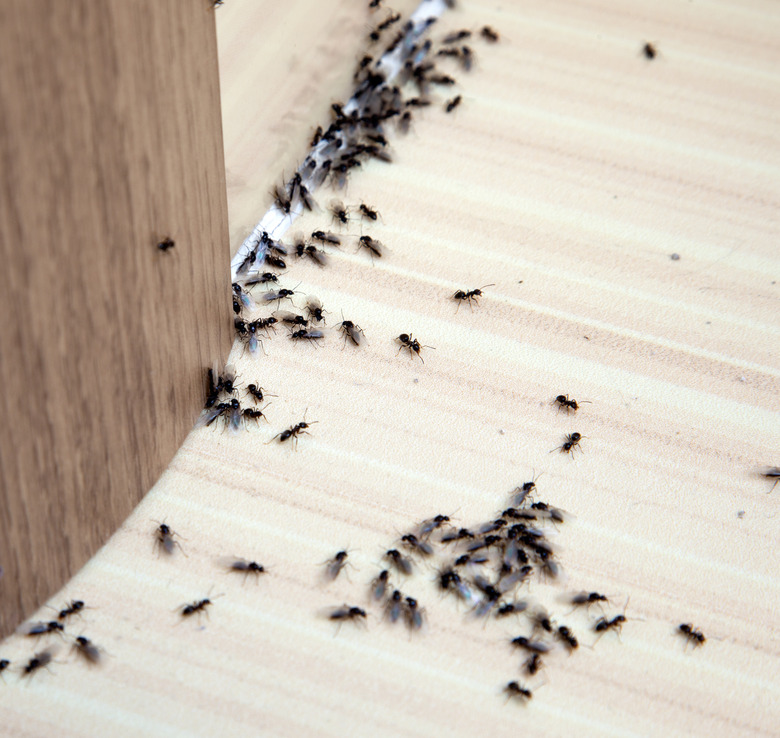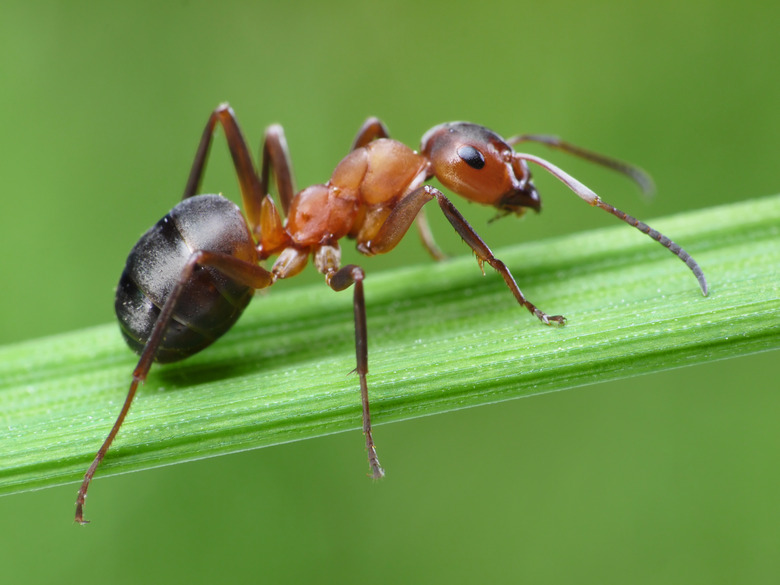How To Get Rid Of Ants In The House
We may receive a commission on purchases made from links.
"The ants go marching one by one" is in the first verse of the cute kids' song, but when those little pests are marching across your kitchen counter, it's not so cute anymore. Nobody likes these pests in the house, so it's useful to know how to get rid of ants. Sometimes, it's a good idea to consider using professional pest control services — though you can often do it yourself.
There are literally thousands of species of ants in the world, but not all of them are likely to show up in your house. The ones you are most likely to find indoors include odorous house ants (better known as house ants) and carpenter ants. These ants don't bite or spread disease, but they are considered the United States' number one nuisance bug indoors. House ants are the most common, and they are usually attracted into the home by spilled or accessible food. They are annoying but not dangerous. Carpenter ants are another story. They come inside to build nests in rotten or damp wood, sometimes causing damage to doors and windows.
To get rid of ants once and for all, you need to discover and eliminate whatever is attracting them into your house. Ant bait targets the ant colony or nest and is much more effective than pesticide spray. The best tactic, however, is to use an integrated pest management approach. This combines a variety of methods for getting rid of ants that do not use toxic chemicals.
What Do House Ants Look Like?
What Do House Ants Look Like?
- Species name: House ants (Tapinoma sessile)
- Physical characteristics: They are about 1/8 inch long and have beehive-shaped abdomens. They are either dark brown or black in color. Some emit an offensive odor when threatened or killed.
- Wings or wingless: They are wingless.
How to Get Rid of Ants
How to Get Rid of Ants
Squashing an ant or two on the counter won't get you very far in a quest to rid your house of ants. It is best to invest some time in finding out what is attracting the ants into the house (usually food) and how they are getting in. With that information, you can organize a campaign to make your home less appealing to ants and also less accessible. Eliminating food sources is a great first step.
Clean Up Food Spills
House ants enter your home looking for food. The colony usually sends out scouting parties that return with examples of the food available. Sweet things, like sugar, honey, and syrup, top the list of desirable snacks for ants, but bread crumbs and pet food are also very attractive. If the food samples look promising, the ants come marching one by one, two by two, and sometimes in a mad rush.
The first and best tip for keeping ants out of the house is keeping things neat and clean. A sanitary kitchen is especially critical to preventing an ant invasion. Clean up all food spills immediately and thoroughly. Store food on the shelves in closed, airtight containers. Keep floors and cabinet tops spotless and never stack dirty dishes in the sink, planning to wash them the next day. Trash containers are also attractive to ants, so clean and empty them frequently. Pick up pet food dishes when your pets finish eating.
Get Rid of Damp Areas
Finding and getting rid of wet, rotting wood primarily is a preventative measure for eliminating carpenter ants, but it also helps with house ants. That's because both species of ants prefer to dwell in moist areas. For example, make sure you don't have water leaks from any pipes or on the roof. This is particularly important in the bathroom, which is usually the most humid room of the house.
Use Ant Bait Traps
It's tempting to blast that parade of ants marching across your pantry shelf with powerful pesticide, but using toxins in the kitchen is never a good idea. In addition, while you may take out a few ants, there is an entire nest of them somewhere, including a queen and other worker ants.
It's better to use insecticidal ant bait traps, also called bait stations, which are very effective solutions to an ant infestation. The traps contain sweet, sugary syrup that will kill the ants that eat it. Since the ant scouts will take the bait back to the nest for the queen and other colony members to eat, you are attacking the colony, not just the scouts.
Where should you place ant bait traps? The obvious answer is wherever you see a trail of ants. You can also look for ant trails in likely spots in kitchens or bathrooms. Shine a flashlight behind and beneath large kitchen appliances, like refrigerators, stoves, and dishwashers, as well as under the sinks and cabinets in both rooms. Don't forget to look around floor drains and inside the motor areas of refrigerators and microwaves. When ant trails are found, set your bait trap.
Make a DIY Bait Trap
If you are a DIY-type individual, you can make your own ant bait trap using borax. Borax comes in granulated or powder form, and either can be used to make ant bait. When ants eat this boron compound, they die.
To make borax attractive to ants, you'll need to mix it up with something they like. Sugar, honey, or syrup work well. Set out the bait carefully to be sure that kids or household pets don't ingest it, as borax is toxic and should not be ingested or come in contact with the skin or eyes. When the ants carry borax back to the nest as food, other members of the colony are also poisoned by it.
Block Ant Entry Points
While carpenter ants enter via wet, damaged wood corridors, house ants can squeeze their way in through cracks and gaps in your home's walls or roof. Implement exclusion techniques to keep the ants out. Survey the exterior of your home and seal off the points where wires or pipes enter. Caulking holes and repairing the plaster on your walls can take care of many ant issues.
It's also a good idea to keep tree branches trimmed so that they don't touch the house. This goes for all outdoor plants near enough to the home that their branches can provide a superhighway for arriving ants. Cleaning up outside the house should be a part of DIY pest control efforts.
When to Hire a Pro
When to Hire a Pro
Many indoor ant infestations can be taken care of by the homeowner with simple efforts, like keeping a sanitized home and using ant bait traps. However, if things feel out of control, there are a variety of pest control professionals who can come to help.
In general, if the ants with which you are dealing are of a species that stings or bites (like fire ants) or of a species that can weaken the wooden structure of your home (like carpenter ants), you might want to talk to a pest control company. As with any professional you hire, it's best to get references from friends and neighbors and also get several bids before selecting the company to hire.
Getting Rid of Ants Naturally
Getting Rid of Ants Naturally
Those who wish to get rid of ants without killing them have a few options. Closing off entry points and eliminating food spills may be sufficient, but there are a few home remedies to repel ants that people swear by. These repellents use natural ingredients that are either displeasing to ants or eliminate their scent trails.
Strong smells are said to repel ants or, at the very least, destroy their scent trails and prevent others from following them. Among the smells reputed to work are ground pepper, cinnamon, peppermint essential oils, apple cider vinegar, lemon or orange juice, and coffee grounds. Some claim that flour scattered in doorways or on windowsills impedes ants from passing. As a last resort, consider running a trail of sugar from your kitchen out to your compost pilef, where ants can dine to their heart's content without bothering your home.
How Quickly Can You Get Rid of Ants?
How Quickly Can You Get Rid of Ants?
You may not like to hear it, but the quickest way to get rid of ants in the house is probably by doing a thorough cleaning of the kitchen and pantry area. The most common types of ants in the house enter to find food. Taking a couple of hours to scour the kitchen, including counters, stove top, cabinets, garbage cans, and floors, can solve the ant problem as if by magic. The grand parade will stop overnight.
How Ants Get in Your House
How Ants Get in Your House
Ants are unwelcome visitors in any home, but most houses have an ant problem from time to time. It starts with a few ants taking a look, but if they like what they find, then they let the entire colony know about it. Suddenly, it's an ant infestation.
How do they get indoors to begin with? Ants slip into the house through cracks or holes, often near a door or window. They may also find enough space where pipes or electric cords enter the home. (A bit of spackle or caulking can help.) It's also possible for them to come in through the roof, and this is especially a problem if trees grow beside the home and form a bridge from soil to roof.
In most regions, ants are largely a nuisance in the warmer seasons rather than the winter. While some ant species build their nests outdoors and come inside the home to find food, many of the most common ant species, like odorous house ants, enter your home and build a nest inside.
Ant propagation is complex. Ant colonies begin with one queen. She mates only once and then stores the male's sperm in a specialized pouch. She can open the pouch whenever she needs sperm to fertilize the eggs she produces. That means that there is no single mating season, and new ants can be produced at any time.
Do Ants Cause Damage/Spread Disease?
Do Ants Cause Damage/Spread Disease?
Ants can play an important ecological role in the garden, as they aerate the soil and also provide a food source for birds. Indoors, they cause problems, and some species are more problematic than others. The common house ant is largely a nuisance that is unwelcome but not destructive. They don't transmit disease or cause any real damage to your home.
On the other hand, there are between 12,000 and 22,000 classified ant species worldwide, ranging from common house ants to exotic species. Some have the potential to damage your property, sting you, or spread disease. Pharaoh ants can carry salmonella and several other diseases. European fire ants deliver a painful sting.


